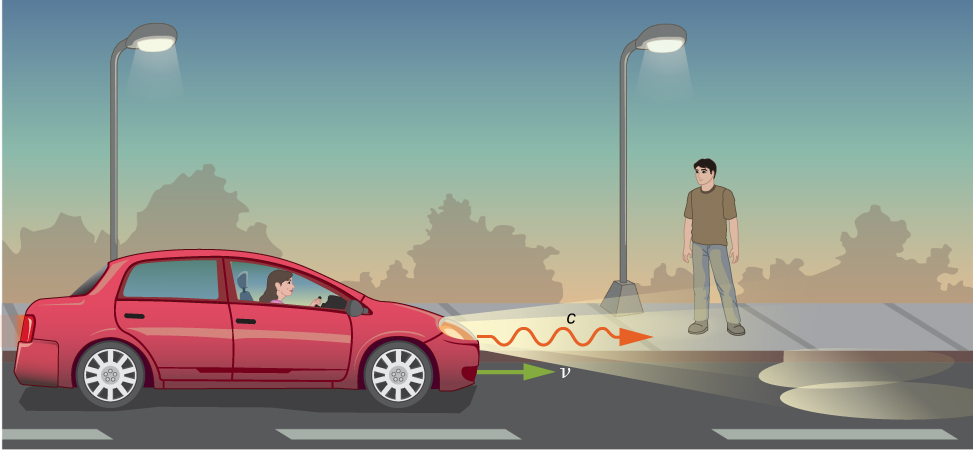5.7: Relativistic Velocity Transformation
( \newcommand{\kernel}{\mathrm{null}\,}\)
By the end of this section, you will be able to:
- Derive the equations consistent with special relativity for transforming velocities in one inertial frame of reference into another.
- Apply the velocity transformation equations to objects moving at relativistic speeds.
- Examine how the combined velocities predicted by the relativistic transformation equations compare with those expected classically.
Remaining in place in a kayak in a fast-moving river takes effort. The river current pulls the kayak along. Trying to paddle against the flow can move the kayak upstream relative to the water, but that only accounts for part of its velocity relative to the shore. The kayak’s motion is an example of how velocities in Newtonian mechanics combine by vector addition. The kayak’s velocity is the vector sum of its velocity relative to the water and the water’s velocity relative to the riverbank. However, the relativistic addition of velocities is quite different.
Velocity Transformations
Imagine a car traveling at night along a straight road, as in Figure 5.7.1. The driver sees the light leaving the headlights at speed c within the car’s frame of reference. If the Galilean transformation applied to light, then the light from the car’s headlights would approach the pedestrian at a speed u=v+c, contrary to Einstein’s postulates.

Both the distance traveled and the time of travel are different in the two frames of reference, and they must differ in a way that makes the speed of light the same in all inertial frames. The correct rules for transforming velocities from one frame to another can be obtained from the Lorentz transformation equations.
Relativistic Transformation of Velocity
Suppose an object P is moving at constant velocity u=(u′x,u′y,u′z) as measured in the S′ frame. The S′ frame is moving along its x'-axis at velocity v. In an increment of time dt', the particle is displaced by dx′ along the x'-axis. Applying the Lorentz transformation equations gives the corresponding increments of time and displacement in the unprimed axes:
dt=γ(dt′+vdx′/c2)dx=γ(dx′+vdt′)dy=dy′dz=dz′.
The velocity components of the particle seen in the unprimed coordinate system are then
dxdt=γ(dx′+vdt′)γ(dt′+vdx′/c2)=dx′dt′+v1+vc2dx′dt′dydt=dy′γ(dt′+vdx′/c2)=dy′dt′γ(1+vc2dx′dt′)dzdt=dz′γ(dt′+vdx′/c2)=dz′dt′γ(1+vc2dx′dt′)
We thus obtain the equations for the velocity components of the object as seen in frame S:
ux=(u′x+v1+vu′x/c2),uy=(u′y/γ1+vu′x/c2),uz=(u′z/γ1+vu′x/c2).
Compare this with how the Galilean transformation of classical mechanics says the velocities transform, by adding simply as vectors:
ux=u′x+u,uy=u′y,uz=u′z.
When the relative velocity of the frames is much smaller than the speed of light, that is, when v≫c, the special relativity velocity addition law reduces to the Galilean velocity law. When the speed v of S′ relative to S is comparable to the speed of light, the relativistic velocity addition law gives a much smaller result than the classical (Galilean) velocity addition does.
Suppose a spaceship heading directly toward Earth at half the speed of light sends a signal to us on a laser-produced beam of light (Figure 5.7.2). Given that the light leaves the ship at speed c as observed from the ship, calculate the speed at which it approaches Earth.

Strategy
Because the light and the spaceship are moving at relativistic speeds, we cannot use simple velocity addition. Instead, we determine the speed at which the light approaches Earth using relativistic velocity addition.
Solution
Identify the knowns: v=0.500c; u′=c.
Identify the unknown: u.
Express the answer as an equation: u=v+u′1+vu′c2.
Do the calculation:
u=v+u′1+vu′c2=0.500c+c1+(0.500c)(c)c2=(0.500+1)c(c2+0.500c2c2)=c.
Significance
Relativistic velocity addition gives the correct result. Light leaves the ship at speed c and approaches Earth at speed c. The speed of light is independent of the relative motion of source and observer, whether the observer is on the ship or earthbound.
Velocities cannot add to greater than the speed of light, provided that v is less than c and u′ does not exceed c. The following example illustrates that relativistic velocity addition is not as symmetric as classical velocity addition.
Suppose the spaceship in the previous example approaches Earth at half the speed of light and shoots a canister at a speed of 0.750c (Figure 5.7.3).
- At what velocity does an earthbound observer see the canister if it is shot directly toward Earth?
- If it is shot directly away from Earth?

Strategy
Because the canister and the spaceship are moving at relativistic speeds, we must determine the speed of the canister by an earthbound observer using relativistic velocity addition instead of simple velocity addition.
Solution for (a)
- Identify the knowns: v=0.500c; u′=0.750c.
- Identify the unknown: u.
- Express the answer as an equation: u=v+u′1+vu′c2.
- Do the calculation: u=v+u′1+vu′c2=0.500c+0.750c1+(0.500c)(0.750c)c2=0.909c.
Solution for (b)
- Identify the knowns: v=0.500c; u′=−0.750c.
- Identify the unknown: u.
- Express the answer as an equation: u=v+u′1+vu′c2.
- Do the calculation: u=v+u′1+vu′c2=0.500c+(−0.750c)1+(0.500c)(−0.750c)c2=−0.400c.
Significance
The minus sign indicates a velocity away from Earth (in the opposite direction from v), which means the canister is heading toward Earth in part (a) and away in part (b), as expected. But relativistic velocities do not add as simply as they do classically. In part (a), the canister does approach Earth faster, but at less than the vector sum of the velocities, which would give 1.250c. In part (b), the canister moves away from Earth at a velocity of −0.400c, which is faster than the −0.250c expected classically. The differences in velocities are not even symmetric: In part (a), an observer on Earth sees the canister and the ship moving apart at a speed of 0.409c, and at a speed of 0.900c in part (b).
Distances along a direction perpendicular to the relative motion of the two frames are the same in both frames. Why then are velocities perpendicular to the x-direction different in the two frames?
- Answer
-
Although displacements perpendicular to the relative motion are the same in both frames of reference, the time interval between events differ, and differences in dt and dt′ lead to different velocities seen from the two frames.


